News
Full Recap of Tesla’s 2015 Annual Shareholder Meeting
At the Tesla Annual Shareholder Meeting, chairman Elon Musk touched on a number of subjects, including cars, the GigaFactory, battery storage and space travel.

During his remarks at the Tesla annual shareholder meeting on Tuesday, chairman Elon Musk touched on a wide range of topics from the AutoPilot system, the GigaFactory, residential and utility scale grid storage, and life on Mars. Here’s a synopsis.
Car Stuff
Musk told the meeting that he anticipates sales volume will continue to grow 50% per year, on average, for the next several years. The company has opened a new casting and machining center near the Fremont factory. Moving production functions there has opened up room at the factory to install a new assembly line capable of producing 3 times as many cars as the current line. A new paint facility capable of handling up to 500,000 cars a year has also been installed.
The Model X is undergoing final pre-production tweaking and will start production in “3 to 4 months.” In response to a question, Musk said that mounting the battery pack low in the chassis makes the Model X one of the safest SUV’s on the road. He went on to say that, like the Model S, it will achieve some of the highest crash test ratings of any car on the road.
“[I]t’s turning out to be a really great car. I think the Model X may arguably be a better SUV than the Model S is as a sedan. We want to make sure obviously that some of the key features of the Model X, particularly the Falcon Wing door and the way the second row seats are done …is…just right, and provide true functionality and true value improvements versus just sort of feeling gimmicky. It’s got to be a genuine improvement in utility and aesthetics, so getting those final nuances right for the Model X is what we’re focused on right now.”
When asked about the affordable mass-market Model 3, he said it would be available only with a single motor at first to keep costs down but would be offered in a dual motor version as well.
He did have exciting news about the Supercharger network. The company is fitting solar panels to as many Supercharger locations as possible. He assured the audience that those that could not be converted to solar power would soon get their electricity only from renewable power sources.
Musk also said the company has created a new liquid cooled charging cord that is significantly thinner and more flexible than the one used now. Not only does liquid cooling make the cable more elegant, it will permit the use of higher powered Supercharger facilities in the future.
He emphasized that the system will continue to expand in North America and other countries to permit Tesla owners to enjoy free long distance driving for life. He did say that owners who use Superchargers for all their daily charging can expect to receive a “note” from the company.
With regard to the AutoPilot suite of autonomous driving features, Musk indicated that the company is busy testing and upgrading the system. “We’re making gradual progress towards what I’d say is a releasable bit of software. But it is quite a tricky thing and we want to make sure that our testing is exhaustive before we release the software. But if we keep making progress, I think we may be able to get it out to all the access customers which is sort of our public beta program around the end of this month.”
Full implementation is not expected for about 3 years, with a lot depending on how regulators in the US and abroad react to it. He said that the system at this point is intended to function like the auto pilot in airplanes — there to help but not to allow drivers to sleep through their journey to arrive alert and refreshed at their destination…..yet.
Musk admitted that interest in battery swapping was far lower than expected. He indicated that the company is focusing more on improving Supercharger performance and less on building battery swap locations.
Tesla PowerWall
One of the biggest announcements of the day concerns the Tesla PowerWall. Some critics have chirped that the units introduced to great fanfare in April were too small to be worth the cost. “I am very happy to announce that we’ve dramatically increased the power capability of the Powerwall. So it’s actually going to go from having 2 kilowatts steady, 3.3 kilowatt peak to a 7 kilowatt power, 5 kilowatt steady, price is unchanged. So, it basically more than doubled the power output of the Powerpack and the price is going to stay the same.”
The company will prioritize deliveries to people who already have a residential solar system or who are installing one. Why? Because an inverter will be already included in their system, meaning adding a PowerWall will cost only about $3,500 for the unit and about $500 for installation. That’s huge.
But even with that announcement, Musk admitted that the PowerWall may not make economic sense for most customers in the US because the differences between the cost of electricity during a 24 hour period are usually not large enough for there to be a pay back on the cost of the system in a reasonable period of time. He cites Germany, Australia and Hawaii as markets where the PowerWall makes more economic sense.
The company focus is on grid scale storage, which it expects will account for 80% of its stationary battery business. “That’s where the economics are very compelling because there is an important difference between price and cost. The cost to the utilities of between day and night is quite substantial because the power usage is often sort of 2:1 at least if not greater than 2:1, sometimes substantially greater than 2:1 between peak day usage and trough night usage.”
Musk told the audience that utility companies look favorably on using Tesla battery storage units because they are more compact than what competitors offer, so they can fit into the footprint of existing substations without the need to acquire more land and the permitting issues that may create. He says utilities are just like residential customers — they appreciate that the Tesla units are basically “plug and play” ready, with no hassles or headaches.
The GigaFactory
Musk said the GigaFactory was coming along smoothly, with production expected to begin next year with full capacity expected within 3 years. In response to a question from the audience, he responded, “Our focus right now is just making sure that we build the Gigafactory version one correctly and that’s going to be quite a difficult challenge over the next few years. We’ll have the first part of it active next year but then we want to try to get to full production in roughly three years…that’s going to be quite a challenge. And I think once we get to that point we want to figure out where to put Gigafactory Two and Three.”
He says the GigaFactory will have the capacity to build 50 gigawatt-hours of batteries a year. “And that should allow for 500,000 cars to be produced a year plus have 15 gigawatt-hours left over for stationary. The way it’s looking, demand for stationary is higher than expected, so we’re looking at potentially expanding the output capability of the Gigafactory to meet the higher demand for stationary.”
SpaceX
An audience member asked when SpaceX would be going public and Musk responded that a SpaceX IPO was a long way off, primarily because the stock market is focused on quarterly reports and has an attention span limited to 1 to 2 years maximum. He said the timeline for SpaceX was quite a bit beyond that. Then he dropped this bomb:
“I’m trying to build a city on Mars and that ends up sacrificing profitability for a really long time. I think it would be not super loved by the public markets. I’d expect with SpaceX that we will probably go public once we will have a regular flights to Mars.”
The Take Away
One stockholder asked Elon Musk what his goals for the company are. He gave this answer, which may serve as the overarching statement that underlies everything he and his various companies are attempting to accomplish.
“Our goal at Tesla is pretty straight forward; it’s really to accelerate the advent of sustainable energy and particularly sustainable transport. So in order for humanity to have a good future or for life…we have to figure out how to make that future sustainable, meaning not to have crazy amounts of CO2 in the atmosphere and ultimately get into situation of hydrocarbon scarcity, which would be economically disastrous.
“So, that’s what we’re focused on. Our primary goal is to accelerate the advent of sustainable transport and then, with the batteries, help the advent of sustainable energy production.”
Quoted material is courtesy of Seeking Alpha transcription service.
News
SpaceX’s Crew-11 mission targets July 31 launch amid tight ISS schedule
The flight will lift off from Launch Complex 39A at Kennedy Space Center in Florida.

NASA and SpaceX are targeting July 31 for the launch of Crew-11, the next crewed mission to the International Space Station (ISS). The flight will lift off from Launch Complex 39A at Kennedy Space Center in Florida, using the Crew Dragon Endeavour and a Falcon 9 booster.
Crew Dragon Endeavour returns
Crew-11 will be the sixth flight for Endeavour, making it SpaceX’s most experienced crew vehicle to date. According to SpaceX’s director of Dragon mission management, Sarah Walker, Endeavour has already carried 18 astronauts representing eight countries since its first mission with NASA’s Bob Behnken and Doug Hurley in 2020, as noted in an MSN report.
“This Dragon spacecraft has successfully flown 18 crew members representing eight countries to space already, starting with (NASA astronauts) Bob (Behnken) and Doug (Hurley) in 2020, when it returned human spaceflight capabilities to the United States for the first time since the shuttle retired in July of 2011,” Walker said.
For this mission, Endeavour will debut SpaceX’s upgraded drogue 3.1 parachutes, designed to further enhance reentry safety. The parachutes are part of SpaceX’s ongoing improvements to its human-rated spacecraft, and Crew-11 will serve as their first operational test.
The Falcon 9 booster supporting this launch is core B1094, which has launched in two previous Starlink missions, as well as the private Ax-4 mission on June 25, as noted in a Space.com report.
The four-members of Crew-11 are NASA astronauts Zena Cardman and Mike Fincke, as well as Japan’s Kimiya Yui and Russia’s Oleg Platonov.
Tight launch timing
Crew-11 is slated to arrive at the ISS just as NASA coordinates a sequence of missions, including the departure of Crew-10 and the arrival of SpaceX’s CRS-33 mission. NASA’s Bill Spetch emphasized the need for careful planning amid limited launch resources, noting the importance of maintaining station altitude and resupply cadence.
“Providing multiple methods for us to maintain the station altitude is critically important as we continue to operate and get the most use out of our limited launch resources that we do have. We’re really looking forward to demonstrating that capability with (CRS-33) showing up after we get through the Crew-11 and Crew-10 handover,” Spetch stated.
Lifestyle
EV fans urge Tesla to acquire Unplugged Performance for edge in fleet and security industry
Unplugged Performance has built a name for itself by producing performance upgrades for Tesla vehicles.

A growing number of Tesla enthusiasts and longtime community voices are calling on the electric vehicle maker to acquire Unplugged Performance, a California-based aftermarket company best known for tuning Tesla vehicles and developing specialized government fleet solutions under its UP.FIT division.
The idea was once considered a niche proposal among EV fans, but it is now gaining serious attention not just as a performance play but as a strategic move to deepen Tesla’s roots in the fleet and security industry.
A strategic fit
Unplugged Performance has built a name for itself by producing performance upgrades for Tesla vehicles, from track-optimized components to visual and aerodynamic upgrades. But in recent years, its UP.FIT division has pivoted toward a more functional future by outfitting Tesla vehicles like Model Ys for police, military, and government use.
That work has sparked growing calls for closer collaboration with Tesla, especially as the EV maker increasingly leans into autonomy, AI, and fleet services as core components of its next chapter.
“I posted this four years ago, but I think it’s more true now than ever,” wrote Whole Mars Catalog, a well-known Tesla investor and FSD Beta tester, on X. “Tesla should buy Unplugged. But not just as a Performance division. What they are doing with UP.FIT unlocks large government and commercial fleet purchases that can improve utilization.”
Tesla fans such as shareholder Sawyer Merritt echoed the sentiment, calling Unplugged a “great fit within Tesla.” adding, “They are literally located directly next to Tesla’s design studio in Hawthorne.”
Enabling the next wave
Supporters of the idea noted that integrating Unplugged into Tesla’s corporate structure could help accelerate the adoption of autonomous technologies in government sectors. With UP.FIT patrol cars already in use across some U.S. police departments, Tesla fans envisioned a future where self-driving Teslas could potentially revolutionize law enforcement, search-and-rescue, and public service logistics.
“Just imagine how autonomous patrol cars could transform policing and bring us into a safer future,” the veteran FSD tester wrote.
The benefits could also extend to Tesla’s existing consumer base. “They also have some incredible products in the works that I think will appeal to many ordinary Tesla drivers — not just those looking for performance or mods. Stuff that’s so good it should have come straight from the design studio next door,” Whole Mars Catalog noted.
Unplugged Performance, founded in 2013, shares not just a product vision with Tesla, but also geography. Its Hawthorne headquarters sits directly adjacent to Tesla’s design studio, and the two companies have maintained a close working relationship over the years. The aftermarket firm has long positioned itself as a “mission-aligned” partner to Tesla.
In response to the recent calls for acquisition, Unplugged Performance acknowledged the support from the community. “Our very existence is to support the Tesla mission with @UpfitTesla and @UnpluggedTesla,” Unplugged CEO Ben Schaffer posted on X. “We love working with Tesla and are grateful for the community’s support since 2013!”
News
Tesla debuts hands-free Grok AI with update 2025.26: What you need to know
All new Tesla vehicles delivered on or after July 12, 2025, will include Grok AI out of the box

Tesla has begun rolling out Grok, an in-car conversational AI assistant developed by xAI, to eligible vehicles starting July 12. The feature marks the most direct integration yet between Elon Musk’s artificial intelligence startup and Tesla’s consumer product lineup, offering drivers hands-free access to a chat-style companion while on the road.
Grok comes pre-installed on new vehicles
According to Tesla’s FAQ page for the feature, all new vehicles delivered on or after July 12, 2025, will include Grok AI out of the box. Owners of older vehicles may gain access through an over-the-air update, provided their vehicle meets a few hardware and software requirements.
Specifically, Grok is currently only supported on Tesla models equipped with an AMD infotainment processor and running vehicle software version 2025.26 and higher. Compatible models include the Model S, Model 3, Model X, Model Y, and Cybertruck. A Premium Connectivity subscription or active Wi-Fi connection is also required.
Tesla notes that additional vehicle compatibility may arrive in future software updates.
Grok’s features and limitations for now
Drivers can engage with Grok using the App Launcher or by pressing and holding the voice command button on the steering wheel. Grok is designed to answer questions and hold conversations using natural language, offering responses tailored to its chosen personality—ranging from “Storyteller” to the more eccentric “Unhinged.”
For fun, Tesla posted a demonstration of Grok likely running on “Unhinged” talking about what it would do to Optimus when they are on a date, much to the shock of the humanoid robot’s official social media account.
It should be noted, however, that Grok cannot currently issue commands to the vehicle itself, at least for now. Traditional voice commands for tasks like climate control, navigation, or media remain separate from Grok as of writing.
The feature is being released in Beta and does not require a Grok account or xAI subscription to activate, although that policy may change over time.
Grok privacy and in-car experience
Tesla emphasizes that interactions with Grok are securely processed by xAI and not linked to a user’s Tesla account or vehicle. Conversations remain anonymous unless a user signs into Grok separately to sync their history across devices.
Tesla has also begun promoting Grok directly on its official vehicle webpages, showcasing the feature as part of its in-car experience, further highlighting the company’s increasing focus on AI and infotainment features on its all-electric vehicles.
-

 Elon Musk2 weeks ago
Elon Musk2 weeks agoTesla investors will be shocked by Jim Cramer’s latest assessment
-

 Elon Musk3 days ago
Elon Musk3 days agoxAI launches Grok 4 with new $300/month SuperGrok Heavy subscription
-

 Elon Musk5 days ago
Elon Musk5 days agoElon Musk confirms Grok 4 launch on July 9 with livestream event
-

 News1 week ago
News1 week agoTesla Model 3 ranks as the safest new car in Europe for 2025, per Euro NCAP tests
-

 Elon Musk1 week ago
Elon Musk1 week agoxAI’s Memphis data center receives air permit despite community criticism
-

 News2 weeks ago
News2 weeks agoXiaomi CEO congratulates Tesla on first FSD delivery: “We have to continue learning!”
-

 News2 weeks ago
News2 weeks agoTesla sees explosive sales growth in UK, Spain, and Netherlands in June
-

 Elon Musk2 weeks ago
Elon Musk2 weeks agoTesla scrambles after Musk sidekick exit, CEO takes over sales


















